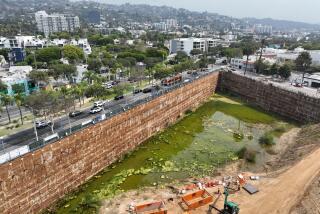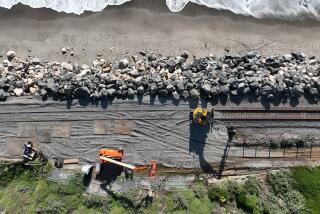Historic Aqueduct in L.A. to Be Buried
- Share via
A remnant of Los Angeles’ historic Zanja Madre water-supply system unearthed this week near Chinatown will be covered over and permanently entombed, the Metropolitan Transportation Authority said Wednesday.
MTA officials accepted responsibility for the accidental unearthing of a portion of the brick-lined “Mother Ditch” at the Cornfield, a onetime rail yard that is scheduled to be used for a 32-acre corn-growing/art project this summer.
Transit officials said a privately contracted construction crew was conducting preliminary grading for a Gold Line rail-line extension next to the site when it sliced into the long-abandoned, 4-foot-wide brick-covered water system.
The Zanja Madre was the city’s primary water source from 1781 to 1904. It was supplied by a large waterwheel next to the Los Angeles River at the eastern edge of the Cornfield site.
Crews have voluntarily halted work at the site and cordoned off the ditch’s exposed brick while experts study the historic find, MTA spokesman Rick Jager said.
A spokeswoman for the Annenberg Foundation, which is financing artist Lauren Bon’s “Not a Cornfield” conceptional art project, said it is doubtful the discovery will delay the scheduled May corn planting.
“It is not on our site. It’s not on our piece of the Cornfield,” Barbara Bronson Gray said of the ditch remnant.
But Gray said the foundation would be interested in possibly including the exposed section of the Zanja Madre as an educational display during the art project.
“You could meander through the corn to see it. Could we have a path to it?” she asked.
“We’re ready to use all of this to educate people. We’re well-positioned to include this.”
MTA officials, however, said that would not be possible because of safety concerns.
“It’s not an area that would be accessible to the public. It would be very highly dangerous for people to be there,” said Carl Ripaldi, the MTA’s environmental compliance manager.
The transit authority was grading the site in preparation for constructing a retaining wall for a future Gold Line facility when the ditch structure was unearthed, he said.
“Archeologists will thoroughly document it with pictures and photographs. We’ll probably cover it over in a couple of weeks.
“It will be protected and entombed behind the retaining wall,” Ripaldi said.
That news was disheartening to leaders of the Center for Law in the Public Interest, which on Tuesday demanded a halt to construction near the waterway.
It would be a shame to permanently rebury the exposed Zanja Madre, said Erica Flores Baltodano, the center’s assistant director.
“There’s a tremendous interpretive opportunity here. We’d be in support of using this for educational purposes,” Baltodano said. “This is an historic opportunity.”
More to Read
Sign up for Essential California
The most important California stories and recommendations in your inbox every morning.
You may occasionally receive promotional content from the Los Angeles Times.











